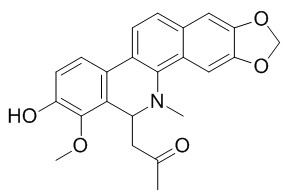6-Acetonyl-N-methyl-dihydrodecarine
6-Acetonyl- N -methyl-dihydrodecarine has mosquito larvicidal activity against the malaria vector Anopheles gambiae.
Inquire / Order:
manager@chemfaces.com
Technical Inquiries:
service@chemfaces.com
Tel:
+86-27-84237783
Fax:
+86-27-84254680
Address:
1 Building, No. 83, CheCheng Rd., Wuhan Economic and Technological Development Zone, Wuhan, Hubei 430056, PRC
Providing storage is as stated on the product vial and the vial is kept tightly sealed, the product can be stored for up to
24 months(2-8C).
Wherever possible, you should prepare and use solutions on the same day. However, if you need to make up stock solutions in advance, we recommend that you store the solution as aliquots in tightly sealed vials at -20C. Generally, these will be useable for up to two weeks. Before use, and prior to opening the vial we recommend that you allow your product to equilibrate to room temperature for at least 1 hour.
Need more advice on solubility, usage and handling? Please email to: service@chemfaces.com
The packaging of the product may have turned upside down during transportation, resulting in the natural compounds adhering to the neck or cap of the vial. take the vial out of its packaging and gently shake to let the compounds fall to the bottom of the vial. for liquid products, centrifuge at 200-500 RPM to gather the liquid at the bottom of the vial. try to avoid loss or contamination during handling.
Pharmacognosy Journal2019, 11,6:1235-1241
National Natural Science Foundation of China2024, pages 33.
Korean Journal of Pharmacognosy2018, 49(1):76-83
Food Funct.2022, 13(14):7638-7649.
Foods.2022, 12(1):136.
Chin Med.2022, 17(1):66.
LWT2021, 138:110397.
Molecules.2023, 28(2):727.
J Pharm Biomed Anal.2016, 129:50-59
Biomed Pharmacother.2024, 181:117647.
Related and Featured Products
Pesticide Biochem. Physiol., 2011, 99(1):82-5.
Mosquito larvicidal activity of alkaloids from Zanthoxylum lemairei against the malaria vector Anopheles gambiae[Reference:
WebLink]
METHODS AND RESULTS:
Four alkaloids, 10-O-demethyl-17-O-methylisoarnottianamide 1, 6-Acetonyl-N-methyl-dihydrodecarine 2, nitidine 3, and chelerythrine 4 were isolated from the plant Zanthoxylum lemairei (Rutaceae) and evaluated for mosquito larvicidal activity against the malaria vector Anopheles gambiae. The mortalities of the larvae were determined after 24 h. The results of the larvicidal tests demonstrated that compounds 1 and 2 were the most potent with mortality rates of 96.7% and 98.3% at a concentration of 250 mg/L, respectively. Compound 3 was less potent with a mortality of 28.3% at the same concentration. The percent mortality of 100% was observed at a concentration of 500 mg/L. The least potent of the four alkaloids was compound 4, which achieved 100% mortality at 1000 mg/L.
CONCLUSIONS:
These findings could be useful in the research for newer more selective, biodegradable and natural larvicidal compounds or can be used as lead compounds for the development of larvicides.
J. Braz. Chem. Soc, 2009,20(2): 379-382.
Fernandes CC et al. 6-acetonyl-N-methyl-dihydrodecarine, a new alkaloid from Zanthoxylum riedelianum. [Reference:
WebLink]
METHODS AND RESULTS:
A new benzophenanthridine alkaloid, 6-Acetonyl-N-methyl-dihydrodecarine was isolated from Zanthoxylum riedelianum roots together with lupeol, 6-acetonyldihydrochelerythrine and 6-acetonyldihydroavicine. The structures were established from the IR, MS and NMR spectral data, including 2D-NMR experiments.



